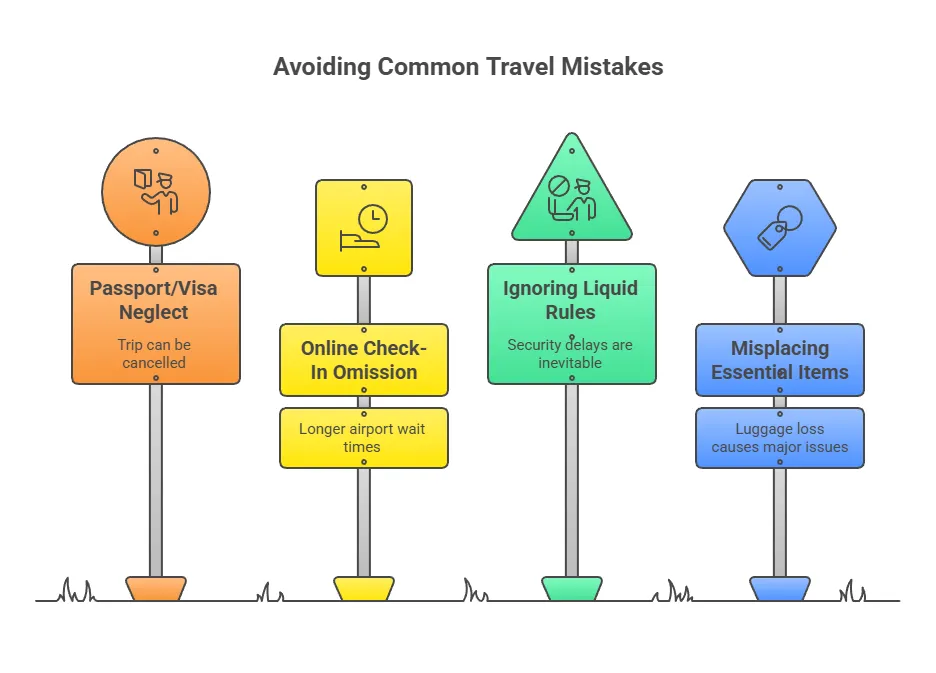On This Page
Introduction: Treating the Airport Like a System to Be Managed
For a first-time traveler, an airport can feel like a chaotic, stressful environment. It’s loud, crowded, and full of confusing signs. But as someone who has spent years optimizing complex systems, I see airports differently. An airport is a process—a sequence of predictable steps with clear rules. The anxiety and chaos that many people feel is simply the result of not understanding that system.
This is not a list of vague “travel tips.” This is an operational manual. We will break down the most common airport mistakes for first-time travelers into a logical, chronological sequence. By understanding these potential “system failures” in advance, you can design a process for yourself that makes your airport experience smooth, efficient, and stress-free.
Phase 1: Critical Errors Before You Leave Home
Your airport journey begins long before you call a taxi. The most catastrophic failures happen due to poor preparation at home.

Mistake #1: Not Checking Your Passport and Visa Requirements
This is the ultimate trip-killer. You absolutely must check two things at least a month before you travel: 1) Your passport’s expiration date. Many countries require your passport to be valid for at least six months *after* your planned departure date. 2) The visa requirements for your destination. Don’t assume you can get a visa on arrival. Use an official source like the U.S. Department of State’s travel website to verify.
Mistake #2: Forgetting to Check In Online
Airlines allow you to check in online (or via their app) up to 24 hours before your flight. Doing this is not just a convenience; it’s a critical step. It confirms your seat, allows you to pay for any checked bags at a lower price than at the airport, and provides you with your digital boarding pass. Skipping this means you’ll be stuck in a longer line at the airport. Checking in online and having no checked bags allows me to bypass the check-in counter entirely, saving an average of 30-45 minutes.
Mistake #3: Ignoring Carry-On Liquid Rules (The 3-1-1 Rule)
This is the most common cause of delays at security. The TSA’s 3-1-1 rule is non-negotiable: liquids, aerosols, gels, creams, and pastes must be in containers of 3.4 ounces (100 milliliters) or less, per item. All of these containers must fit inside one clear, quart-sized, zip-top bag. That’s one bag per passenger. Don’t be the person holding up the line while a security agent throws away your expensive sunscreen.
Mistake #4: Packing Essential Items in Your Checked Bag
Assume your checked bag will be delayed or lost. It’s a low-probability, high-impact event you must plan for. Never pack the following items in your checked luggage: your passport, any required medications, house keys, car keys, cash, credit cards, or electronics. All of these critical system components must be in your carry-on bag with you at all times.
Phase 2: System Failures at the Airport
You’ve made it to the terminal. Now the focus shifts to navigating the airport’s internal processes efficiently.

Mistake #5: Mismanaging Your Arrival Time
The old “arrive 2 hours before a domestic flight, 3 hours for international” is a dangerously outdated guideline. The only data that matters is the current reality. Use tools like the MyTSA app or your airline’s app to check real-time security wait times at your specific terminal. For a major hub like JFK or LAX on a holiday weekend, you might need 3+ hours even for a domestic flight. Not checking this data is a gamble you don’t want to lose.
Mistake #6: Not Preparing for the Security Screening
The security line is a simple, predictable process. Have your boarding pass and ID out and ready *before* you get to the front of the line. As you approach the conveyor belt, take your laptop out of your bag and put it in its own bin. Take off your jacket, belt, and any heavy jewelry. Being prepared makes the process smooth for you and everyone behind you. I have a system for this. My laptop is always in an easily accessible sleeve, and I put my phone, keys, and wallet into my jacket pocket before I even get in line. When I get to the belt, I just put the jacket in a bin. It’s a three-second process.
Mistake #7: Paying Exorbitant Currency Exchange Fees
Airport currency exchange kiosks offer the worst possible exchange rates. It’s a trap for uninformed travelers. The most efficient system is to use a debit card with no foreign transaction fees to withdraw local currency from an ATM upon arrival at your destination. For credit card purchases, always use a card with no foreign transaction fees. See our guide to the best travel cards for more.
Phase 3: Final Hurdles at the Gate
You’re through security, but there are still a few final failure points to navigate before you’re on the plane.

Mistake #8: Not Monitoring Your Gate and Boarding Time
Your gate number and boarding time are not static variables; they can change. Don’t just go to the gate printed on your boarding pass and put on your headphones. Check the departure monitors as you walk through the terminal, and re-verify your gate on the monitor at the gate itself. Gate changes are common, and if you miss the announcement, you could miss your flight.
Mistake #9: Ignoring Boarding Group Numbers
When the gate agent announces boarding, don’t just rush the gate. Airlines use a numbered or zoned boarding process to manage the flow of people onto the plane. Your group number is printed on your boarding pass. Crowding the gate before your group is called only creates chaos and slows the process down for everyone. Wait until your group is called to approach the gate.
Mistake #10: Not Having a Downloaded Boarding Pass
Relying on airport WiFi or a cell signal to pull up your digital boarding pass at the gate is a high-risk move. Airport connectivity can be unreliable. Always take a screenshot of your boarding pass or, even better, add it to your phone’s digital wallet (like Apple Wallet or Google Wallet). This ensures it’s instantly accessible, even with no internet connection.
Conclusion: The Airport System, Mastered
Avoiding the most common airport mistakes for first-time travelers isn’t about luck; it’s about having a solid process. By treating your journey as a sequence of logical steps—preparation at home, efficient navigation at the airport, and situational awareness at the gate—you eliminate the variables that cause stress and chaos.
With a good system in place, the airport transforms from a source of anxiety into a simple, predictable, and even enjoyable part of your adventure. You’ve got the playbook; now you’re ready to fly.
Frequently Asked Questions
How early should I really get to the airport for the first time?
For your very first time, it’s wise to be conservative. The “2 hours for domestic, 3 hours for international” rule is a good starting point. But more importantly, check your airline’s app and the MyTSA app for real-time security wait times before you leave for the airport and adjust accordingly.
What is the 3-1-1 liquids rule for carry-on luggage?
The 3-1-1 rule is the TSA’s name for their liquid restrictions. Liquids must be in containers of 3.4 ounces (100ml) or less. All these containers must fit into 1 clear, quart-sized bag. Each passenger is allowed 1 of these bags.
Can I bring a reusable water bottle through security?
Yes, you absolutely can, provided that it is empty. You can bring an empty reusable bottle through the security checkpoint and then fill it up at a water fountain or bottle-filling station on the other side. This is a great way to save money and stay hydrated.


